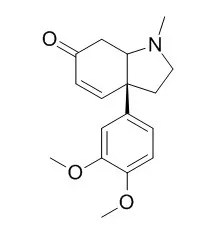| Kinase Assay: |
| J Ethnopharmacol. 2011 Oct 11;137(3):1124-9. | | Pharmacological actions of the South African medicinal and functional food plant Sceletium tortuosum and its principal alkaloids.[Pubmed: 21798331] | The South African plant Sceletium tortuosum has been known for centuries for a variety of traditional uses, and, more recently, as a possible source of anti-anxiety or anti-depressant effects. A standardised extract Zembrin(®) was used to test for pharmacological activities that might be relevant to the ethnopharmacological uses, and three of the main alkaloids were also tested.
METHODS AND RESULTS:
A standardised ethanolic extract was prepared from dried plant material, along with the purified alkaloids mesembrine, Mesembrenone and mesembrenol. These were tested on a panel of receptors, enzymes and other drug targets, and for cytotoxic effects on mammalian cells.
The extract was a potent blocker in 5-HT transporter binding assays (IC(50) 4.3 μg/ml) and had powerful inhibitory effects on phosphodiesterase 4 (PDE4) (IC(50) 8.5 μg/ml), but not other phosphodiesterases. There were no cytotoxic effects. Mesembrine was the most active alkaloid against the 5-HT transporter (K(i) 1.4 nM), while Mesembrenone was active against the 5-HT transporter and PDE4 (IC(50)'s<1 μM).
CONCLUSIONS:
The activity of the Sceletium tortuosum extract on the 5-HT transporter and PDE4 may explain the clinical effects of preparations made from this plant. The activities relate to the presence of alkaloids, particularly mesembrine and Mesembrenone. |
|
| Structure Identification: |
| Anal Bioanal Chem. 2015 Jan;407(3):761-78. | | GC-MS, LC-MS(n), LC-high resolution-MS(n), and NMR studies on the metabolism and toxicological detection of mesembrine and mesembrenone, the main alkaloids of the legal high [Pubmed: 25240931] |
METHODS AND RESULTS:
Mesembrine and Mesembrenone are the main alkaloids of Sceletium tortuosum, a plant species that was used for sedation and analgesia by the KhoiSan, previously known as Hottentots, a tribe in South Africa. After fermentation, the obtained preparation called "Kanna" or "Kougoed" was used by chewing, smoking, or sniffing.After a common user's low dose application of mesembrine, mainly the O- and N demethyl-dihydro, hydroxy, and bis-demethyl-dihydro metabolites, and in case of Mesembrenone only the N-demethyl and the N-demethyl-dihydro metabolite could be detected in rat urine using the authors' standard urine screening approaches (SUSA) by GC-MS or LC-MS(n).
CONCLUSIONS:
Thus, it should be possible to monitor a consumption of mesembrine and/or Mesembrenone assuming similar pharmacokinetics in humans. |
|






 Cell. 2018 Jan 11;172(1-2):249-261.e12. doi: 10.1016/j.cell.2017.12.019.IF=36.216(2019)
Cell. 2018 Jan 11;172(1-2):249-261.e12. doi: 10.1016/j.cell.2017.12.019.IF=36.216(2019) Cell Metab. 2020 Mar 3;31(3):534-548.e5. doi: 10.1016/j.cmet.2020.01.002.IF=22.415(2019)
Cell Metab. 2020 Mar 3;31(3):534-548.e5. doi: 10.1016/j.cmet.2020.01.002.IF=22.415(2019) Mol Cell. 2017 Nov 16;68(4):673-685.e6. doi: 10.1016/j.molcel.2017.10.022.IF=14.548(2019)
Mol Cell. 2017 Nov 16;68(4):673-685.e6. doi: 10.1016/j.molcel.2017.10.022.IF=14.548(2019)